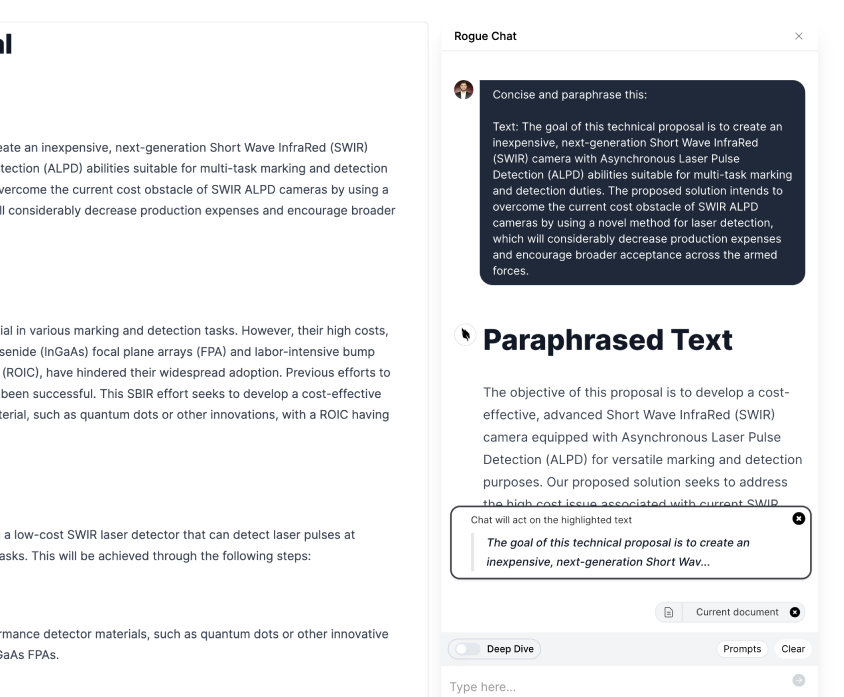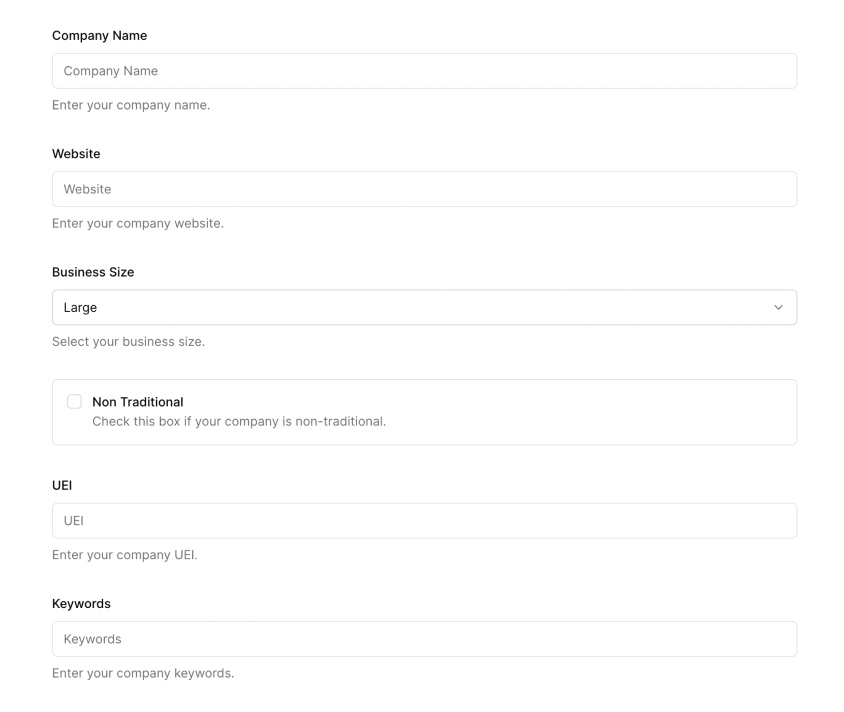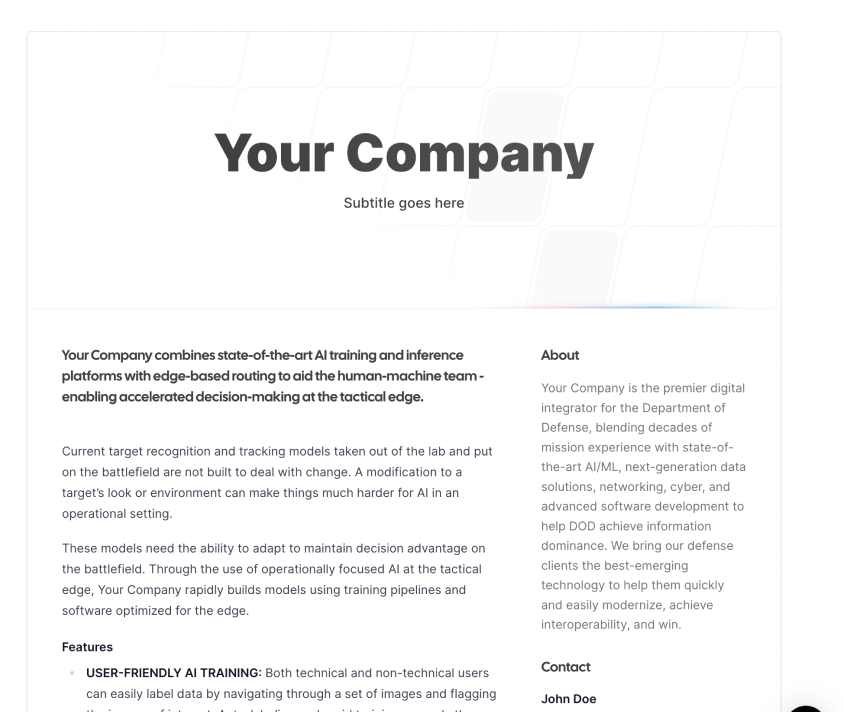
Module 4.c: Prompting Like a Pro
Intro
With the use of advanced prompt engineering techniques, you can easily generate high-quality content for government contracting tasks. These techniques are designed to help you streamline your content creation process and produce content that meets the highest standards of quality. By implementing these strategies, you can ensure that your content is not only engaging but also informative and well-researched. This will help you establish credibility with your readers and build a strong reputation as a reliable source of information. What's more, these techniques are designed to help you save time and resources, allowing you to focus on other important aspects of your business. With the right tools and strategies, you can take your content creation efforts to the next level and achieve greater success in your government contracting endeavors.
I. Precision in Prompt Design
For contractors responsible for various facets of government programs—including business development, security compliance, and information security—efficiency and precision are key. The same principles apply when interacting with AI tools. Ensuring clear and detailed instructions when setting prompts can drastically improve the AI's understanding and response accuracy.
For example, if you're extracting key points from a contract for a stakeholder presentation, instead of using a vague prompt like "Summarize the contract," provide detailed instructions:
Example: Provide a bullet-point summary of the following government contract, focusing on the clauses related to compliance and security measures.
Contract Text: insert contract text here
By being explicit about the context and expected outcome, you enhance the chances of obtaining an accurate and relevant response.
II. Role-Specific Prompts
When dealing with specialized tasks such as security compliance or information security, consider leveraging the AI's 'Persona Pattern'. This allows the AI to operate from the standpoint of a specialized role, like a cybersecurity expert, enhancing the relevance of its output.
Example: Assume the persona of a compliance officer and summarize key legal requirements outlined in the following document related to the Federal Information Security Management Act (FISMA).
III. Constraints on Prompt Size
It's important to understand that language models like ChatGPT have token limitations—usually 2048 tokens, including both prompt and response. For tasks requiring detailed responses, maintain concise yet informative prompts to maximize the utility of the response.
Example: Given the token limitations, summarize the key compliance protocols for data encryption in government contracts in under 300 words.
IV. Refining Queries
In the fast-paced environments of program management and business development, time is often of the essence. Use the AI's 'Question Refinement Pattern' to optimize your queries for more focused answers, particularly when dealing with complex contract language or technical jargon.
Example: If I ask a question about ISO 27001 compliance, suggest a more refined question that considers specific clauses and ask if I want to proceed with the refined query.
V. Kit Bashing
In the realm of generative AI prompting, "kit bashing" refers to the technique of combining pre-existing prompts or prompt fragments to create a new, more specialized or complex prompt. Essentially, you're "bashing" together bits and pieces of previously used prompts to address a specific need. This technique allows for greater flexibility and depth, enabling you to generate more nuanced outputs from the AI model. Suppose you are responsible for security compliance in a government contract, and you also need to manage program elements. You may have two separate sets of prompt fragments: one for assessing cybersecurity measures and another for evaluating program milestones. Kit bashing enables you to create a new prompt that simultaneously checks for cybersecurity compliance and program milestone status.
Example: Assume the roles of both a Program Manager and a Security Compliance Officer. First, evaluate the following program milestones for our government contract and indicate any that are at risk of being delayed. Second, assess the following security protocols to identify potential non-compliance with the Federal Risk and Authorization Management Program (FedRAMP). Provide actionable recommendations for both.
VI. Flipped Interaction
Flipped interaction is a generative AI prompting technique where the AI is asked to ask you questions instead of you asking the AI questions. This can be a great way to test your knowledge, get feedback on your work, or generate new ideas. For example, let's say you are a government contracting company employee who is working on a project to develop a new software application for the government. You could use flipped interaction to test your knowledge of government regulations by asking the AI to ask you questions about those regulations.
Example: Act as a government regulator and ask me questions about the following regulations:
* The Federal Acquisition Regulation (FAR)
* The Cybersecurity Maturity Model Certification (CMMC)
* The General Services Administration (GSA) Acquisition Framework (GAF)
This prompt provides the AI with enough information to generate a series of questions about the specified regulations. You can then answer the questions to test your knowledge of the regulations.
VII. Breaking Down Complexity
When facing multifaceted questions, such as evaluating the risk factors in a complex project, use the 'Cognitive Verifier Pattern' to break the question into smaller, more manageable queries. The AI can then compile the answers to provide a comprehensive response.
Example: If I ask about the security risks in implementing a new software system, break the question down into sub-questions related to software vulnerabilities, data integrity, and regulatory compliance.
VIII. Multi-Persona
Multi-persona prompting is a technique that involves instructing a generative AI model to generate text from the perspective of multiple different personas. This can be a great way to generate creative content, explore different perspectives, or simulate conversations between different people.
For example, let's say you are working on a project to develop a new software application for the government. You could use multi-persona prompting to generate text from the perspective of different stakeholders in the project, such as the government customer, the software developers, and the end users.
Here is a well-crafted example prompt that you could use for multi-persona prompting:
Example: Generate a conversation between a government customer, a software developer, and an end user about the new software application. The conversation should explore the different perspectives of the stakeholders and should highlight the benefits of the new application.
IX. Contextual Learning Through Few-Shot Prompts
Especially beneficial for business development and crafting persuasive proposals, few-shot prompting can guide the AI to produce targeted and contextually apt responses. By providing examples, you set a behavioral template for the AI.
Example: Given these previous project summaries, generate a compelling summary for our new cybersecurity compliance initiative.
X. Progressive Querying with Chain-of-Thought
The chain-of-thought technique is particularly useful for government contractors who are looking to deeply analyze complex issues—be it understanding new federal regulations, dissecting multifaceted contracts, or exploring emerging trends in information security.
In the chain-of-thought approach, you're essentially having a guided conversation with the AI tool, asking subsequent questions based on the AI's prior responses. This enables you to dig deeper into a topic in a structured and progressive manner.
Example Chain for Regulatory Analysis:
- First Query: What is the NIST 800-171?
- Second Query: How does NIST 800-171 affect data management in government contracts with the Federal Government?
- Third Query: What are the penalties for non-compliance with NIST 800-171 these contracts?
This progression allows you to start with a broad question and then narrow your focus, providing you with targeted insights that are highly relevant to your specific concerns in program management, business development, security compliance, and information security.
Example Chain for Information Security Risk Assessment:
- First Query: What are the common types of cyber threats facing government agencies?
- Second Query: How can these cyber threats compromise a government contract?
- Third Query: What preventive measures can be incorporated into a contract to mitigate these risks?
Here, you initiate with a general understanding of the landscape and then guide the conversation toward practical applications and risk-mitigation strategies directly relevant to government contracting.
Example Chain for Technological Impact on Contracting:
- First Query: What are the emerging technologies in data encryption?
- Second Query: How can these technologies be applied to enhance security in government contracts?
- Third Query: What are the potential challenges or risks involved in implementing these technologies?
This sequence helps you understand not only the options available for enhancing contract security but also the challenges and potential risks—information crucial for comprehensive risk management.
XI. More Fun Prompt Ideas
Leveraging AI for Compliance Audits
If you're responsible for ensuring compliance with government regulations, using AI tools can dramatically streamline the audit process. However, the quality of the output is largely dependent on how well you frame your questions and prompts.
Example: Assume the role of a federal compliance auditor. Identify and list potential red flags in the following transaction logs according to the Federal Acquisition Regulation (FAR).
By employing AI in this manner, you can make preliminary assessments more efficiently, freeing you to focus on complex issues that require human judgment.
Data-Driven Business Development
AI can be a valuable asset for business development teams seeking to analyze market trends, competitor strategies, or even the likely success of upcoming bids.
Example: Based on the data provided, generate an analysis of market trends in the defense sector for the past five years. Summarize the key opportunities and threats for government contractors.
Customized Security Protocols
In the realm of information security, you can instruct the AI to offer recommendations tailored to the specific needs of your project or program.
Example: Assume the role of an Information Security Officer. Evaluate the following cybersecurity protocols for a federal cloud storage service and recommend improvements to ensure compliance with the Defense Federal Acquisition Regulation Supplement (DFARS).
Regulatory Update Alerts
While AI models like ChatGPT do not possess real-time knowledge, you can input the latest changes in laws or regulations to get a synthesized understanding of how they might affect your contracts.
Example: Explain the implications of the recently enacted Cybersecurity Maturity Model Certification (CMMC) on existing defense contracts.
Documentation and Report Generation
Creating comprehensive reports is often a laborious task. AI can assist in generating first drafts or outlines, saving considerable time.
Example: Generate an outline for an annual compliance report adhering to the guidelines set by the General Services Administration (GSA).
Enhancing Proposal Quality
A well-crafted proposal can be the difference between winning and losing a government contract. Use the AI's ability to refine and enhance language to improve the quality of your proposals.
Example: Review the following proposal summary and suggest improvements to make it more compelling for a Department of Energy contract.
Utilizing AI for Training Programs
For those involved in program management, AI can help design training modules tailored to specific roles within your team.
Example: Design a training module focused on information security best practices for employees managing sensitive government data.
Assessing Financial Risks
AI can also be used to make preliminary assessments of the financial risks involved in a project or contract.
Example: Analyze the following cost estimates and revenue projections for a government project and highlight any potential financial risks.
XII. Practical Exercise
- Try 3 of the techniques above
- Follow the steps above and share your results in the group
- Give feedback below
GovCon GPT Masterclass
31 lessons
Sign up for Rogue today!
Get started with Rogue and experience the best proposal writing tool in the industry.



